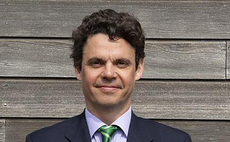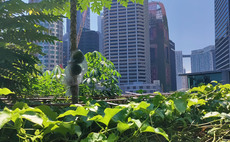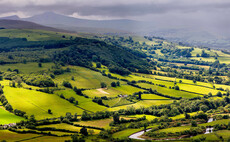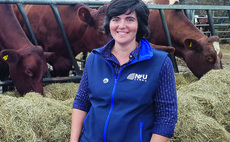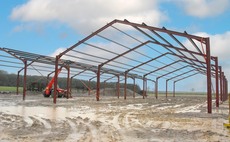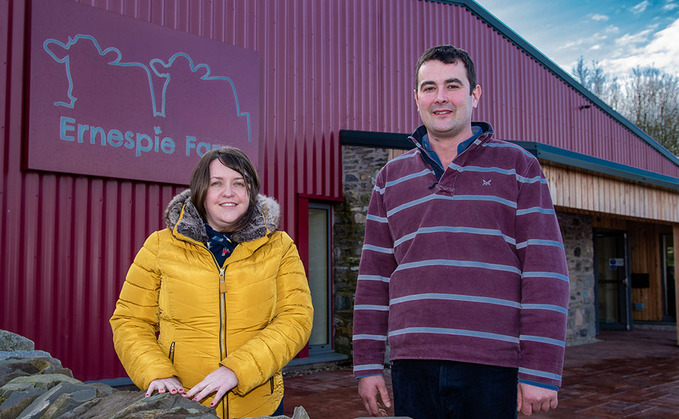
An all-inclusive approach lies behind the success of AgriScot Dairy Farmer of the Year 2019 winners, the McMiken family.
An effort to promote and sustain a well- rounded dairy farming system is one of the keys to success for
the McMiken family at Ernespie Farm, Castle Douglas.
Attention to detail is evident across the whole farming business, with growth and development having kept pace with market demands since the family started business at the farm in the late 1940s.
This has seen the integrated dairy and beef unit develop to its present day set-up, growing from a 150 to 290-head milking herd which saw investment in a new 290-cow capacity housing facility and 20/40 Deleval parlour six years ago and, more recently, the opening of an on-farm visitor centre in July last year.
The farm's day-to-day running falls to third generation farmer David McMiken, who after returning to the family business 16 years ago, farms in partnership with his parents, Brian and Jane, alongside his partner, Rebecca Queen, who is responsible for running the farm visitor centre.
The dairy enterprise spans 200 hectares (500 acres) in total, 120ha (300 acres) of which is owned and the rest rented from neighbouring family who farm nearby, with the opportunity having been there to take on more of this ground as the herd has grown.
A separate beef finishing unit is also managed about three miles away, run over 113ha (280 acres).
Conscious of maintaining high health status, Mr McMiken explains that the pedigree Holstein herd has been closed for 12 years now.
New genetics are bought in via flushing and embryo transfer as part of the farms breeding programme, and developing breeding lines and cow families within the herd is something Mr McMiken says he enjoys doing.
David says: "We are not looking for an extreme animal and I like to breed a cow which is going to suit our system, so I am looking for wide as opposed to tall cows with good locomotion in particular.
"We definitely breed for health traits and fertility now, and with so much available data out there, there is no real excuse not to."
Also included in the farm's breeding policy for the past two years has been a move away from the production of dairy-bred bull calves, with sexed and beef semen now incorporated.
This will see roughly half the heifers receive embryos and the rest served to sexed semen, alongside cows until they are 100 days in-calf, after which they will be AI'd to beef bulls including Simmental and Aberdeen-Angus.
With the recent completion of the visitor centre, Mr McMiken explains there is no huge desire to expand the stock numbers currently and the herd is running at a replacement rate of about 30 per cent.
Surplus milking heifers are sold via Carlisle market and beef-bred animals finished, which sees bulls kept entire and sold pre-16 months and heifers at around 26 months, deadweight via ABP.
Milkers are turned out during the day through the grazing season and will roughly mob graze a platform of about 40ha (100 acres) from the end of May through to about September.
Fields are accessed by a 1,400- metre network of tracks which the McMikens have gradually upgraded themselves from hardcore to concrete.
Operating a year-round calving system, the herd is averaging an annual yield per cow of 10,500 litres, 4,000 of which comes from forage, at 4.2 per cent fat and 3.5 per cent protein.
"Although we maybe lose a bit of yield because we turn the cows out, I enjoy seeing them graze," David says. "With the visitor centre up and running, it works well with this too and people seem to like seeing cows out. But it does also suit some of the ground we have.
"There are fields close to the steading which are not suitable for cutting which can be easily accessed by cows to graze, and we can utilise what could otherwise easily go to waste."
As cattle numbers have risen and with an eye on the dairy's future viability, the decision was taken to invest in new dairy infrastructure six years ago.The aim was to push up milk production, but also with longevity of the cow in-mind.
Funded with the help of a 30 per cent Scottish Rural Development Programme (SRDP) grant, the new cow housing facility and parlour were installed with cow health and comfort at the fore of its design, explains David.
A new 900,000-gallon capacity slurry lagoon was also fitted beneath the suspended, all-slatted shed.
Among other design features, slurry is cleared using a Lely discovery robot, while cubicles are each fitted with a standard design mattress and bedded on dry sawdust.
"The existing sheds were functional but had a limited life-span. I do not think they would have seen me through until retirement," David says.
"Hoof health is an area we pride ourselves in, and as a result of the shed design and system we do not get a lot of abrasion from animals knocking their hooves, which was an important consideration during the design phase.
"A lot of research was also done before the final design and fit of cubicles was decided, as it was important that cows had the right amount of lunging space in-front of them."
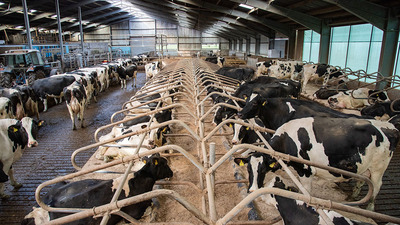
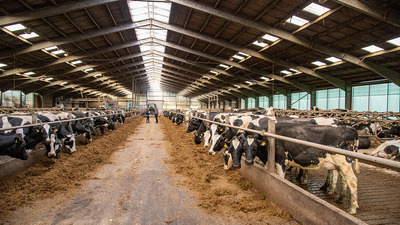
Milkers also go through a foot bath of 1 per cent formalin solution post-milking three times per week, and are foot-trimmed as required, which David does himself.
This ethos extends across the farm, which employs three full-time staff in the form of a herdsman and two general farm labourers, with all the field and cultivation work done in-house or in partnership with family farming nearby to share machinery and labour.
The farm grows about 65ha (160 acres) of cereals, 20ha (50 acres) of which is used for wholecrop and the rest combined. About 100ha (250 acres) of silage is cut each year, and although a shift to a multi-cut system based
on four cuts has been trialled, the farm is now back onto three cuts as desired dry matter levels were not being met.
The current ration is a home-mixed TMR based around home-grown forage and straits, with cows also fed roughly to yield in the parlour.
Having so far attracted some 40,000 visitors since it opened, the enterprise's newest venture is proving to be a success so far. Consisting of a cafe, shop and soft play area, trailer tours through the farm are also offered in the summer during the school holidays, with the farm's proximity to the Solway coast attracting a steady stream of tourists, especially during the warmer months.
"Ever since I have been back at home I have had a vision that I wanted to try and engage with the public a bit more which is where the idea came from," David says.
"We decided to do the tours to show people what is happening on the farm, and it has proved popular.
"Dairy and agriculture as a whole is getting a hard time at the moment, but a lot of it is based on misconceptions and it is rewarding when you actually speak to people and can explain from a farmer's perspective."
Farm facts
- Integrated dairy and beef unit spanning 200 hectares (500 acres) in total and run over two sites, three miles apart
- On-farm visitor centre opened in July 2019 and new cow housing facility and parlour put up six years ago
- 290-head pedigree Holstein milking herd
- Milkers turned out during the day on to 40ha (100 acre) grazing platform from roughly the end of May to September
- Average an annual yield per cow of 10,500 litres, 4,000 of which comes from forage, at 4.2 per cent fat and 3.5 per cent protein
- Milk sold on an Arla 360 contract supplying Morrisons
Aside from his on-farm commitments, David has recently begun a year-long term on the Arla board of representatives, which sees him represent the UK on the European part of the co-op.
Before this, he completed a four-year stint as a district chair for Arla and also currently sits on the NFUS milk committee.
Although commitments which take him off-farm reasonably regularly, the opportunity is one he says has enabled him to learn a lot, which he hopes he can give back to the industry.






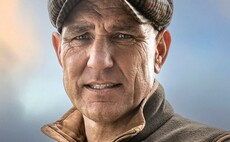

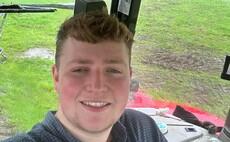
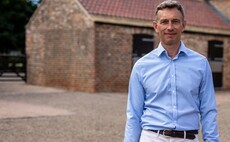

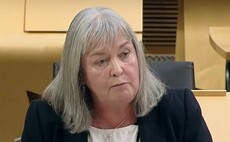

![Farming industry get behind FG's SAVE BRITAIN'S FAMILY FARMS campaign: "[This] campaign will help deliver our message to Government"](https://image.chitra.live/api/v1/wps/af45f99/0f91ad70-ab9b-4ac9-bc2a-53dfa9e75558/10/BOB-Nigel-Owens-0848-Recovered-230x142.jpg)
